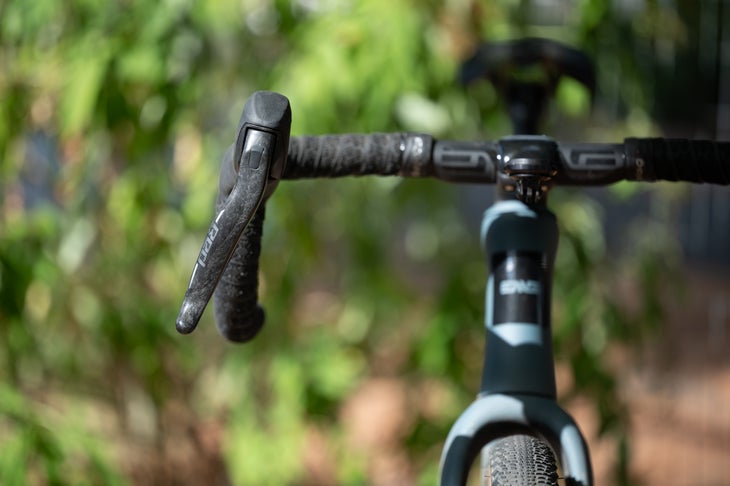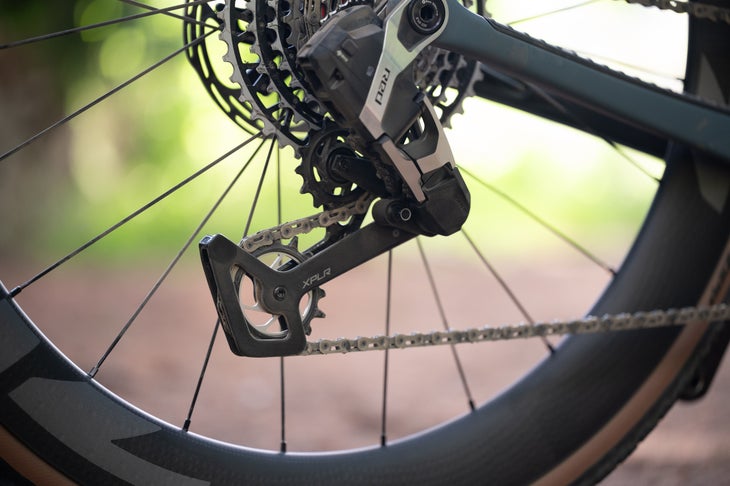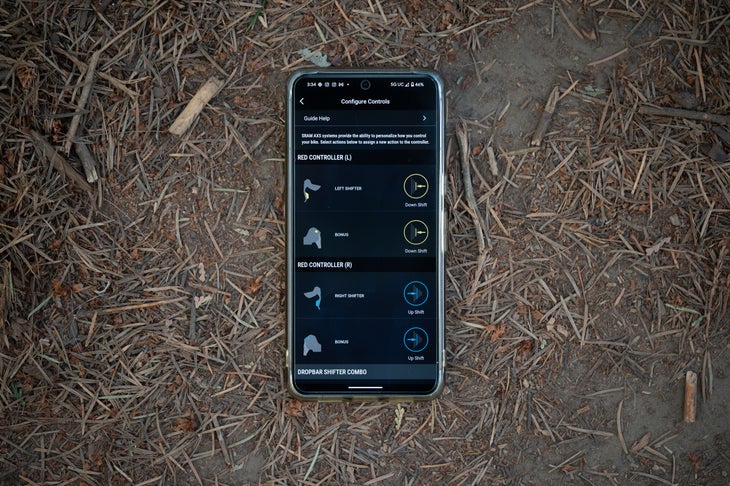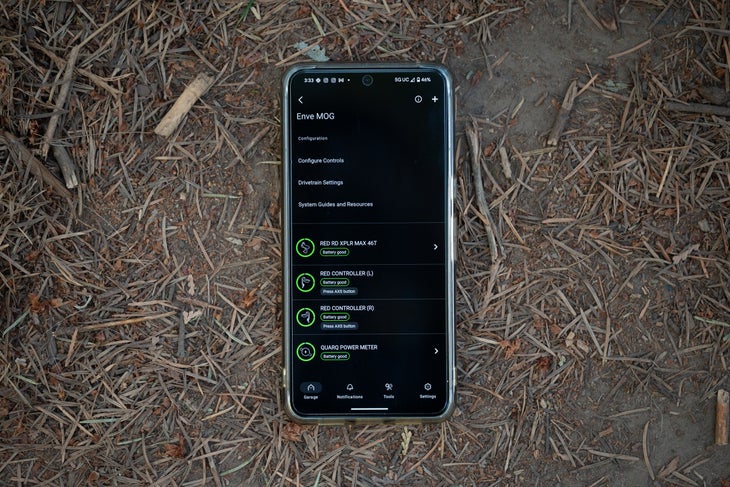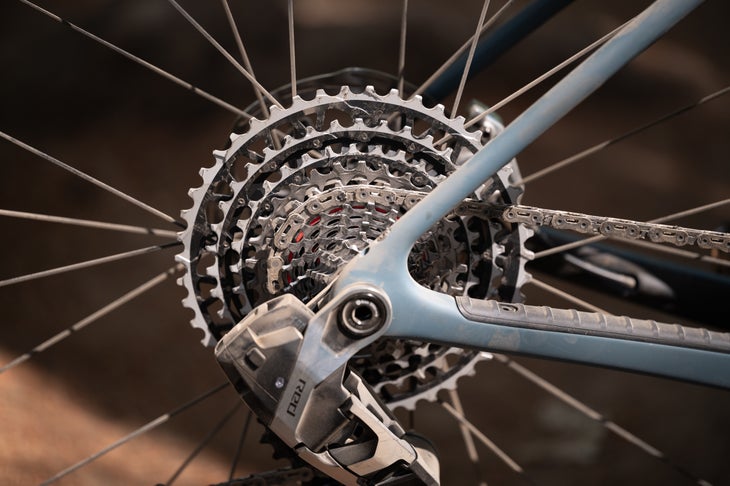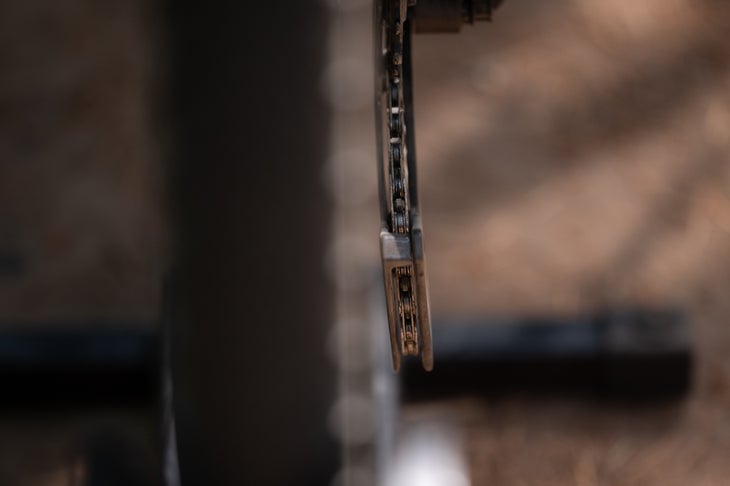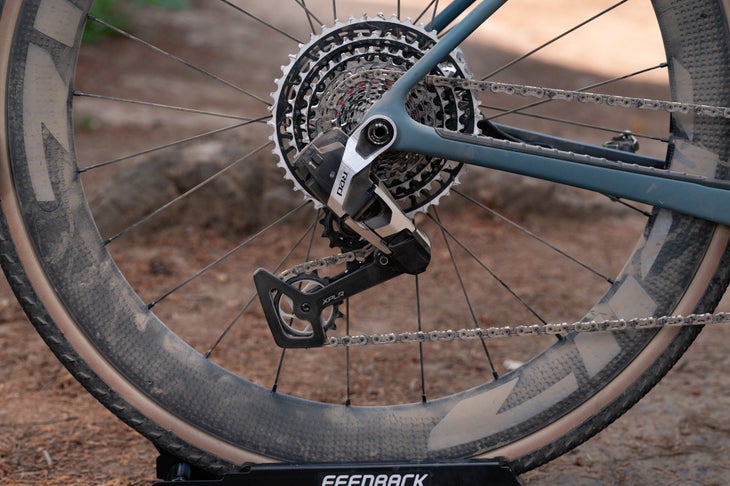It’s hardly a secret that SRAM has a new gravel focused groupset joining our list of component reviews. We saw it show up at this year’s Unbound Gravel race and there’s been a lot of rumors floating around. Given the many leaks, it’s likely that those in the know have an idea that there are 13-cogs out back. Today the leaks end and we know for sure. The 2024 SRAM Red XPLR AXS is 1×13. Now it’s time for details.
At the end of last month I headed to SRAM headquarters to tour the factory and ask all the questions I wanted. Since then I’ve had the opportunity to spend some time riding an Enve MOG equipped with the 2024 SRAM Red XPLR AXS groupset and matching Zipp wheels. I’ll save you the suspense and say right upfront that I think SRAM just set a new standard for gravel bikes. There are details that not everyone will love though. Let’s get into it.
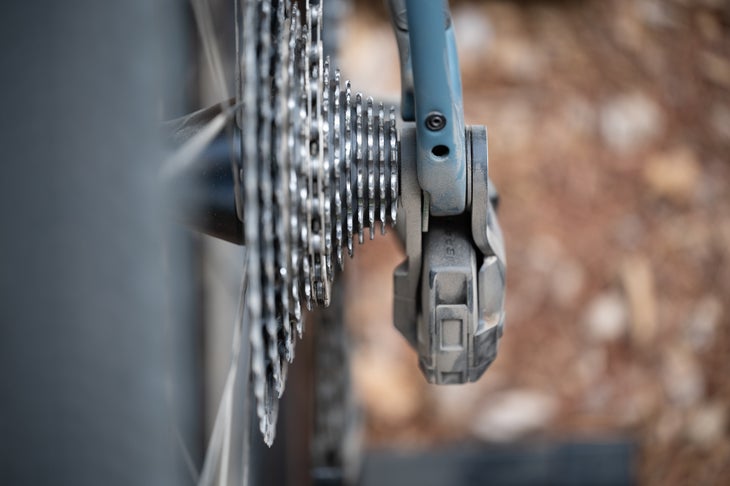
Quick hits: eight things to know about the 2024 SRAM Red XPLR AXS groupset
- It really is 13-cogs on the cassette
- There is only one 10-46 cassette option
- A UDH compatible frame is required
- Chainrings now separate from the power meter
- System weight is 2476 grams
- Controls are the same as the recent SRAM Red Road release
- SRAM Eagle Transmission and 2024 SRAM Red XPLR AXS are functionally similar but Red is optimized for gravel and the only 13-speed option
- 46 is the smallest size possible for the large cog on the cassette meaning 2×13 isn’t likely to come soon
- More details are available at SRAM.com
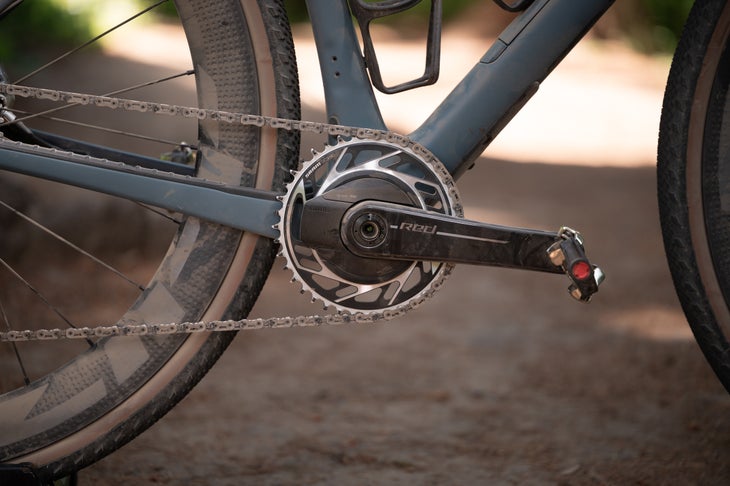
2024 SRAM Red XPLR AXS details
Most things you want to understand about the 2024 SRAM Red XPLR AXS start with the existing SRAM Eagle Transmission derailleur. That means as you move to gravel there are a couple of ideas that SRAM is looking to focus on. The first is that of impact resistance and durability.
The first important detail about that is that this is a UDH only mount. Actually, if I’m being technical, it’s a full mount hangerless interface but for the sake of simplicity, you need a frame with UDH compatibility. Before now you’d use a universal hanger and you’d hang your derailleur on it similarly to how a proprietary hanger works. With a hangerless interface, you leave the UDH off and just mount the derailleur directly to the frame.
That does mean there will be some who are reading this now realizing that an upgrade will mean a new bike frame. Even if that’s okay with you, it will also mean that there will be some whose current dream gravel bike needs more consideration. The list of SRAM UDH compatible gravel frames is growing but it’s not every bike. Keep in mind though, the vast majority of new groupsets come to customers attached to new frames and this is a SRAM Red release. The goal is the best performance, not budget friendly availability for all.
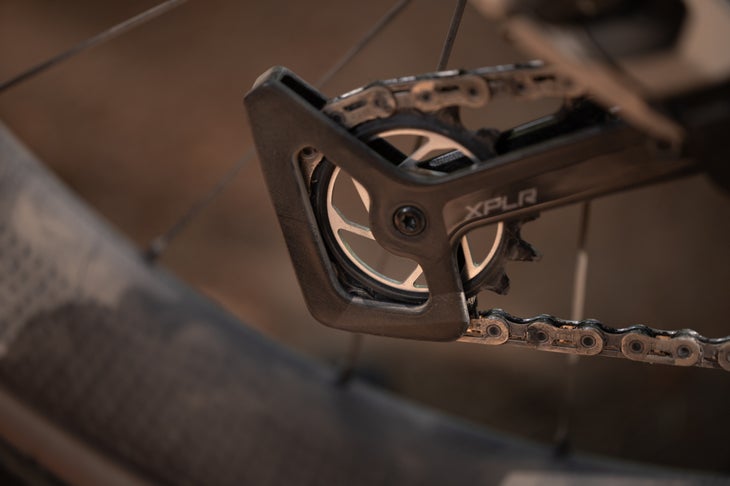
The upside to all this is that the mount is strong and precise. There’s no potential for a slightly bent hanger to affect shift performance and it allows the derailleur itself to handle serious impacts plus mud. SRAM shows a model standing on the derailleur over on the Eagle Transmission product page. That performance now comes to gravel.
In the event of an impact, or if mud jams it, the derailleur will rotate backwards. There’s also the Magic Wheel Pulley that allows the outer chain carrier to continue rotating even if the inner wheel stops. If things do break, there are six skews available for replacement. One of those is the battery latch which fixes a frustrating issue on older derailleurs and aside from that, there’s also the whole lower section with the pulley wheels. It easily unscrews when off the bike so swapping it is simple. What you won’t find is the one spot, where it says RED, that is most likely to experience cosmetic damage. You’ll be able to get things working again but expect to hold onto “battle scars.”
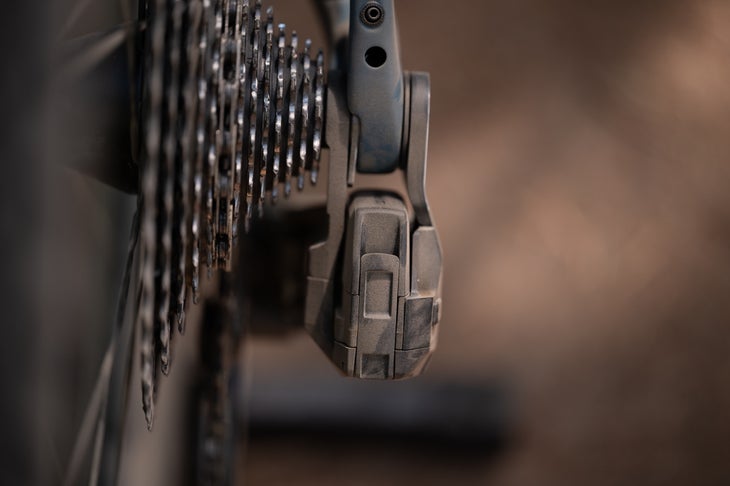
The other advantage of this mounting solution is setup. There are no adjustment screws. SRAM describes it as “prepare, hang, tighten” but what that means is that chain length acts as a limit to movement of the derailleur. Figure out the length of your chainstay, 415 mm is the minimum and it won’t work with suspension, then set your chain length and put everything together. That’s it.
Once you have everything installed, the next part of the 2024 SRAM Red XPLR AXS design is performance. Essentially these are the headline features and the biggest one is that there are 13 cogs at the rear. At least for now, those 13-speeds are set in stone with only the 288 gram XPLR XG-1391 cassette available. Gearing is 10-46 with cogs starting tight at the bottom of the cassette then widening out near the top. If you’re curious, the new cassette is 10,11,12,13,15,17,19,21,24,28,32,38,46 cogs compared to 10,11,13,15,17,19,21,24,28,32,38,44 of the previous XPLR cassettes.
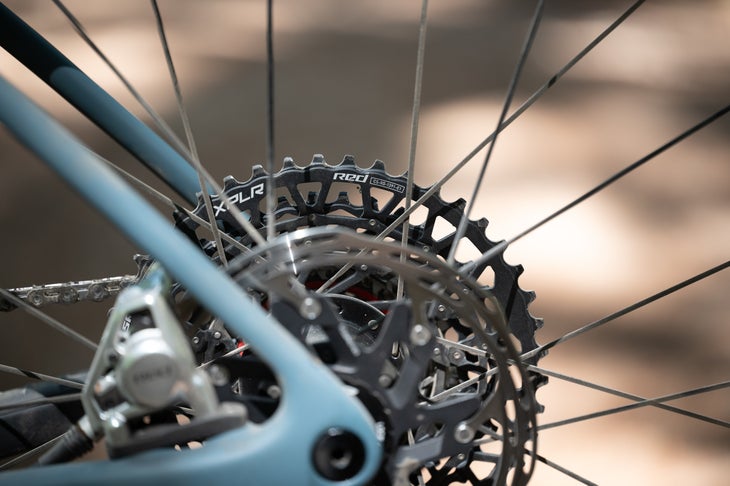
Although there’s only one-cassette available, chainrings are pretty wide open. For years SRAM has been pushing the idea of an integrated chainring/powermeter as the best solution but that’s gone now. This new groupset uses a “Thread Mount” chainring that comes off easily with a special tool. Instead of using the cassette to adjust gearing, you’ll need to adjust it using the chainring with 38T, 40T, 42T, 44T, and 46T options available in a standard chainring or 1x Aero rings, available in 48T, 50T, and 52T. It’s worth noting that since the cassette is tighter at the bottom, it’s advantageous to select gearing that keeps you near the bottom more often.
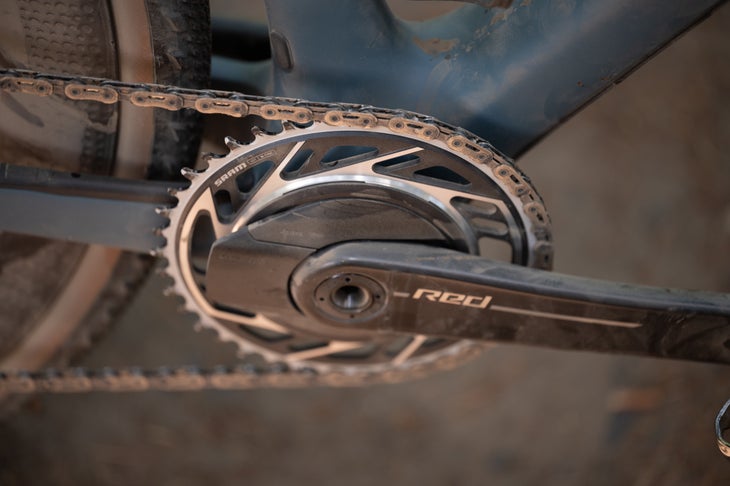
Outside of the chainrings, the crank is essentially the same as the recent SRAM Red road groupset. Although XPLR is wider than road, it uses the same cranks arms with options available for 160, 165, 167.5, 172.5, and 175 mm lengths. If you opt for a powermeter groupset, as I’m told the vast majority of modern riders do, it’s also the same as the road groupset with an accuracy of +/- 1.5%, MagicZero to automatically recalibrate as you ride, and dual sided spider based measurement. Battery life is 200 hours and there is Bluetooth Low Energy or ANT+ for wireless communication. Nothing changes here other than some minor packaging details.
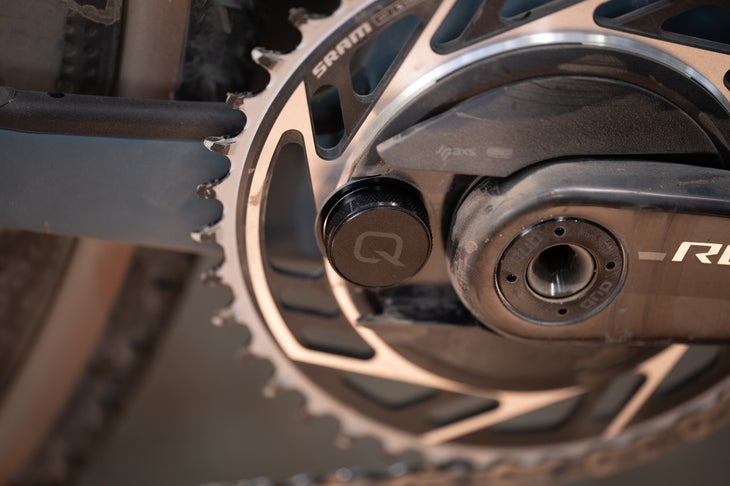
Upfront, there’s more SRAM road with the identical controls as that of the latest SRAM Red road groupset. That means, just as previously covered, the brake reservoir moves from vertical to horizontal to reduce the height of the hoods. There’s a revised pivot point for stronger 1-finger braking performance and more room behind the lever increasing “finger wrap and finger clearance over previous generation controls.” There’s also a bonus button that comes from the factory set as an additional shift button and, like Shimano, the new lines on the hoods help you set the alignment of the controls when installing.
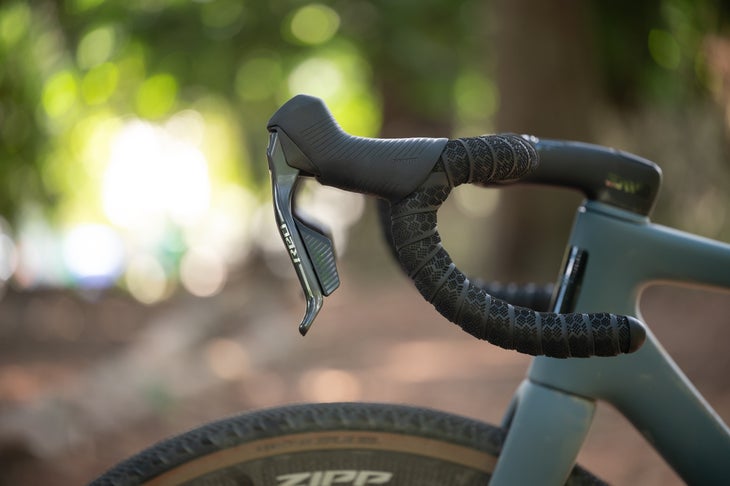
The brakes themselves are also the same as the new for 2024 SRAM Red road groupset. Compared to the previous generation, the “calipers are stiffer and lighter, with increased pad clearance” with the pistons moved slightly outward. Between the revised levers and updates to the calipers, SRAM reports it now requires “80% less effort when braking from the hoods and 33% less effort when braking from the drops over the previous version.”
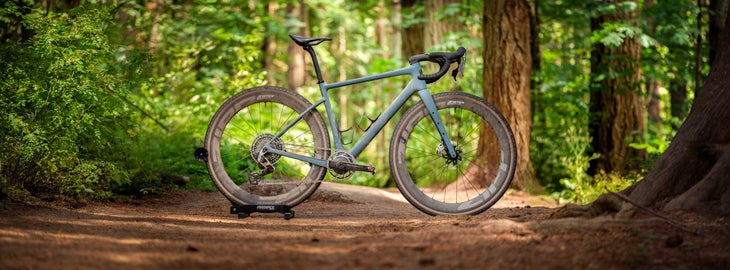
Ride experience
Sometimes with a groupset review there’s a lot to go through. Everything is new and there’s a ton of details. This time, 2024 SRAM Red XPLR AXS is more like a wish list fulfillment. It’s simple to explain because it’s not entirely new. SRAM took what was already working and expanded on it.
Prior to this launch, many SRAM XPLR users wished for the range of a mullet setup. Standard XPLR was great for gravel races but if you found yourself trying to get up a steep single track, or attempting long adventures on steep gravel roads, you wanted the range of a 10-52. The only problem was that if you actually made the jump to a mullet setup, it wasn’t ideal in most situations. The shifting was a bit slow, it was heavy, there were large jumps, and you rarely needed quite that easy of a gear.
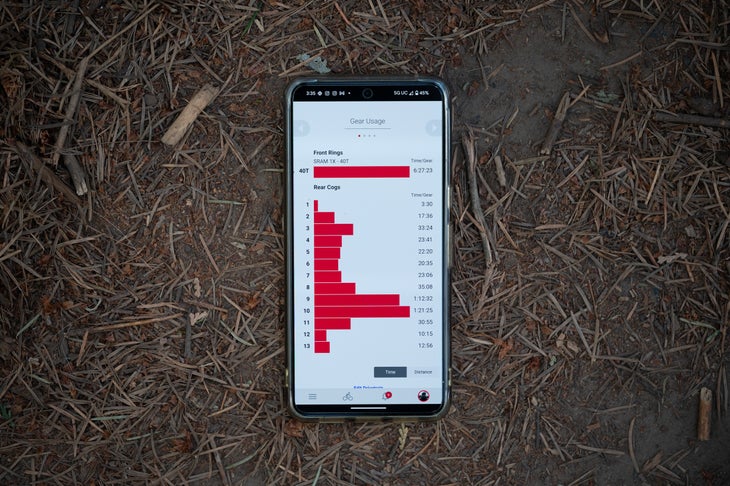
The SRAM Red XPLR AXS groupset is what you actually wanted. It feels like XPLR but all the sudden there’s a massive gear range and no annoying jumps. If you are thinking no one needs 13-speeds, you might be right. That’s not the point though. What people need is range without gaps and that’s what the new Red XPLR AXS offers. The extra cog isn’t the point, it just makes it all work.
For me what that looked like was taking an Enve MOG to my closest gravel riding and going wherever I wanted. I’m hardly a powerhouse but I can push a stiff gear up a steep hill on the road by standing. When I ride off-road I often find myself walking because I need to stand and that loses traction. I’d rather not take the chance of falling over so I walk. With the 13-speed 10-46 cassettes paired to a 40 tooth chainring I can stay seated and preserve my traction while going up whatever silly single track I feel like tackling.
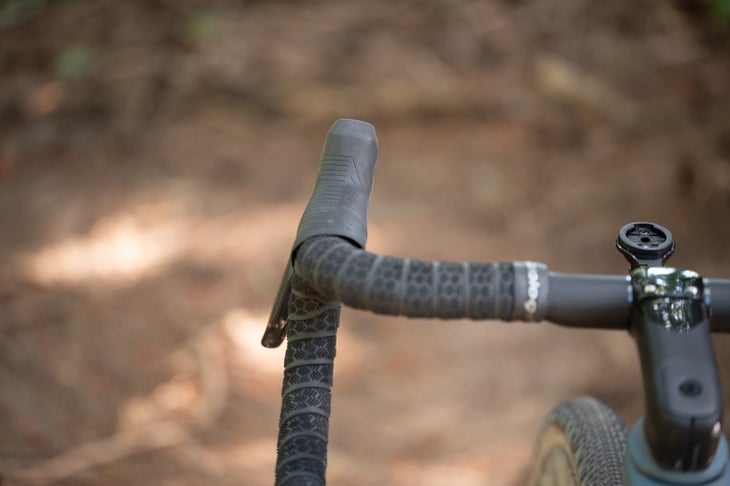
Coming back down is the second revelation with the new groupset. I remember riding in Columbia and experiencing cramps in my wrist as I controlled my descents on steep and rocky “roads.” The new levers completely change that experience. I can grab the hoods, move back on the saddle, and use one or two fingers to modulate the brake power to stay right on the edge of traction. I even managed to hold my Insta360 x4 camera between my thumb and forefinger on a short 12% descent. That’s incredible performance and it allows me to do more.
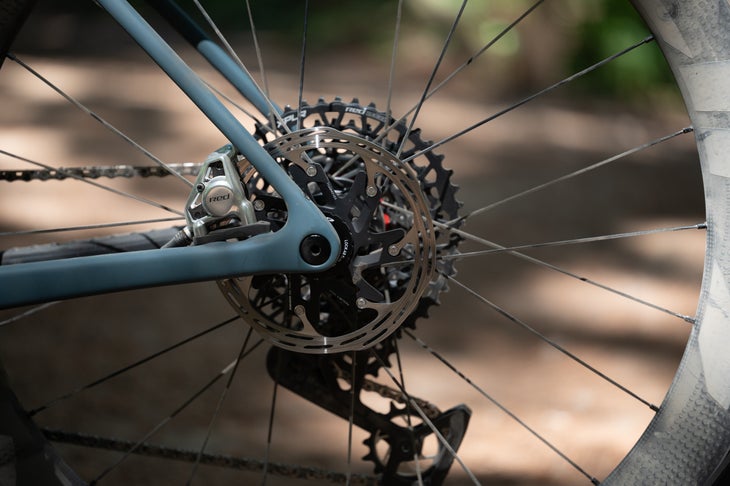
Now I will also say that I’m still not in love with the shape of the hoods compared to Shimano. I’ve spent more time with them on the road but the second time I headed out with the Enve MOG, there was a lot of relatively flat pavement getting to the gravel. My favorite position if I’m pushing is to grab the top of the hoods and although the new shape is smaller, it’s not better than the previous shape. I was always quite happy with the chunky tops that SRAM offered. The new shape is wider and more difficult to grab. It does have one benefit though, the bonus buttons.
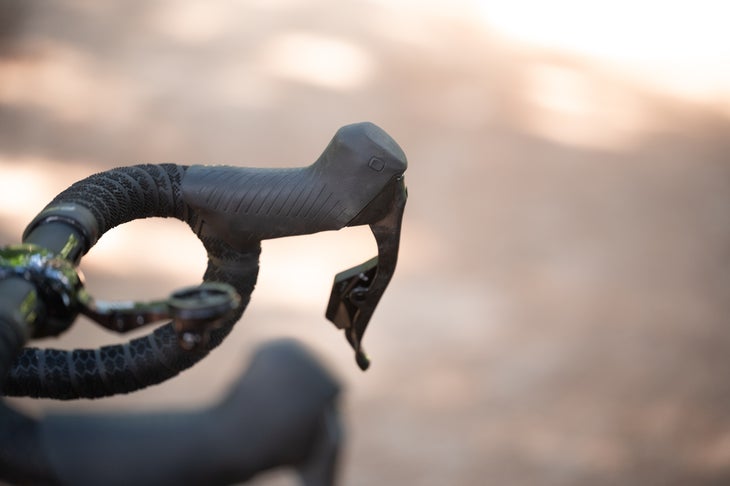
The first time I grabbed the updated controls I immediately thought I’d love them. Then I had a hard time figuring out how to actually push them. It wasn’t until I got into my aero position that I really understood the idea. The bonus buttons default to shifting gears and in that position they are perfectly positioned to shift with your thumb without moving your hand. I love it even if I don’t love the shape as a whole.
Then there’s the durability. Thankfully, I haven’t crashed it yet so for the most part I can’t comment on that. Conceptually what I am in love with is the idea of no more broken or bent hangers. I had someone ask to take a picture of a test bike once, drop it on the drive side, then the derailleur shifted into the carbon spokes and I had to send the wheel back to the manufacturer for help. I’ve also been in the back country and had someone drop a bike (not mine this time) losing shifting, plus I just watched a Badlands video where a moment in a cafe nearly ended the race for someone. All of these were minor falls that resulted in a bent hanger. SRAM just removed that possibility. That could be very helpful and so could the replaceable parts. My only complaint is the lack of a solution for the inevitable scratch in the chrome.
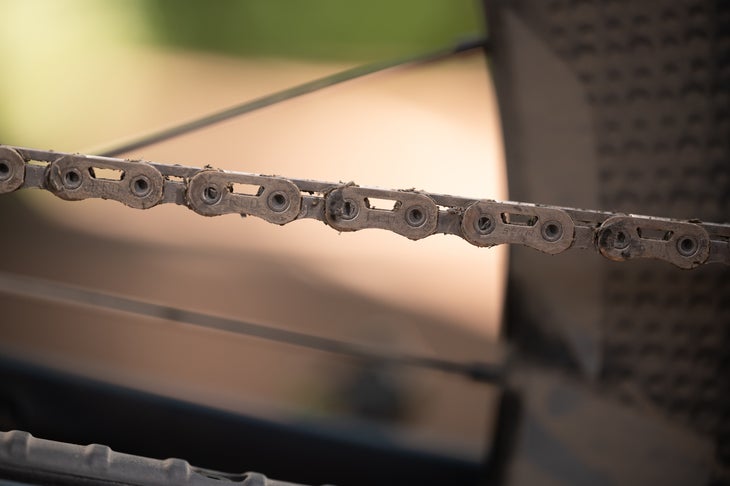
A note about gearing strategy
I tested this groupset and wrote this review then I tested it more. As I started to get close to an hour on the same climb, some thoughts came to me about the gearing strategy and they don’t neatly fit into the rest of the discussion.
With 1×13 coming to market, the first thing everyone wants to know is when there will be 2×13? According to SRAM, not soon and it has to do with the chain. Developing a thinner, stronger, lighter chain took about a decade and it’s what allowed more gears. The existing chain width means that a 13-speed cassette is wider than a 12-speed and it needs to dish onto the wheel. SRAM can’t make a large gear smaller than 46 work.
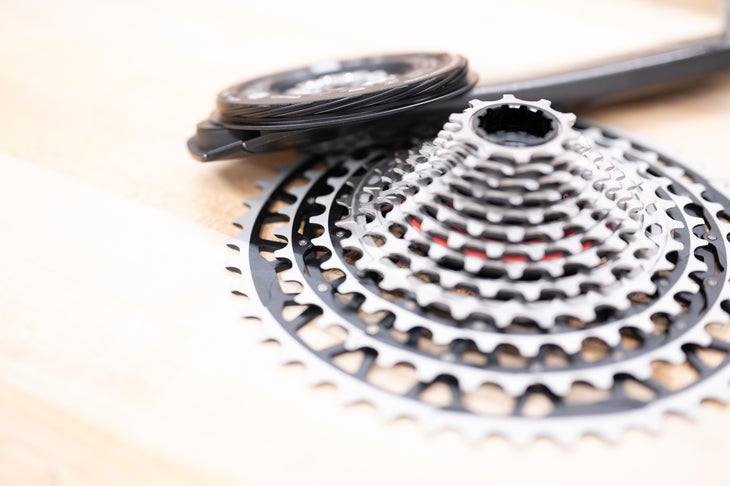
That max gear size limitation locks the cassette size and means there’s no 2×13 incoming. It also means if you want to adjust gearing you’ll need to look at the chainrings. Before today RED AXS XPLR used a somewhat standard 4 bolt 107BCD spider-based power meter and ring. There was also an integrated power meter and chainrings that covered 2x and aero chainrings.
That all stays the same except instead of the standard chainring and spider there’s something new. This new system uses a threaded chainring and a proprietary tool to remove. Our team is locked in a heated debate if that’s a good thing or not and I suspect consumers will have the same debate. My perspective is that I’ve seen enough phantom creeks and damaged frames that I’m ecstatic to wave goodbye to chainring bolts.
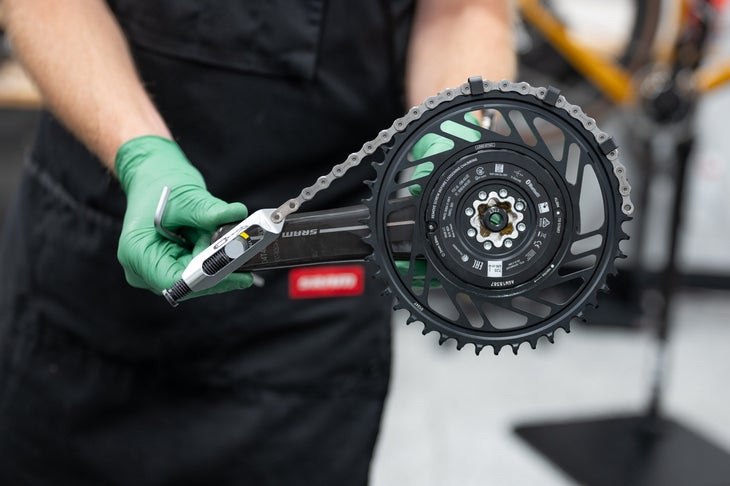
Whatever your feelings, SRAM shared that the vast majority of systems will come with the same 40t x 10-46t I have. I can see why. The range is ideal for most gravel situations and in my own testing a 3 mile average 8% grade climb saw me spend the majority of my time in the 32t and 38t cogs. The 46T was good for above 10% and I can even see places where I was able to pedal through 22%. On the other side of the hill, I was effectively spinning out around 30 mph. I could still put some power down up to about 35 mph but it meant spinning in the 100-110 rpm range.
If I had a road heavy race I might want to move to a 42t but the 40t is ideal for a gravel bike that can do it all.
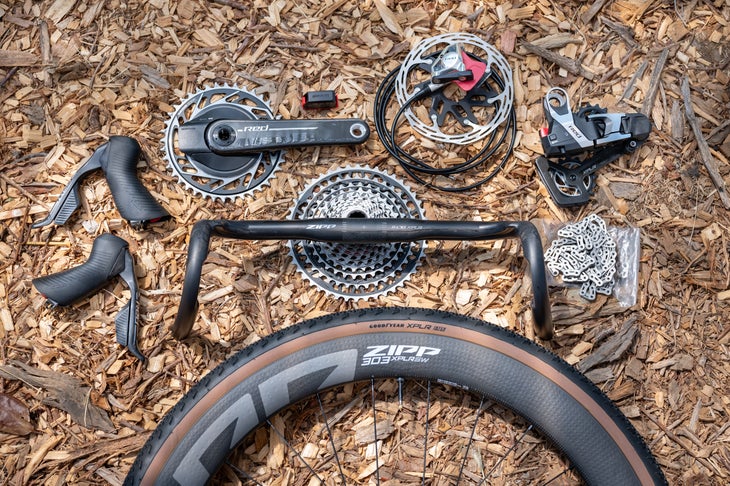
Expanding the groupset
Along with this release, SRAM is also expanding the component offerings. There is a new SL 70 XPLR handlebar and new wheels and tires on offer as well. I’m giving the Zipp 303 XPLR SW gravel wheelset their own article but the handlebar isn’t something I was able to use. The whole trick with the handlebar is that it offers a small shelf to sit just above the hydraulic hose as it exits the controls. There’s also external routing, in the form of deep channels under the bars, that funnel internally (or externally) at the stem.
It sounds smart but there are some issues. To start with, if you pay attention to whatever handlebar you have now, there’s a bump for the hose as it exits the controls. Solving that kind of makes sense except it’s in a spot where it’s a non issue. More important is the hybrid internal/external routing. While I’m sure there will be a large number of people who love this idea, it’s not that workable.
The problem is that Zipp doesn’t have an internally routed stem. That means you need a bike that has internal routing but also comes without a one-piece cockpit. Although that’s increasingly rare, the Enve MOG fits that description and still doesn’t work. I wasn’t able to test it and I won’t be alone.
Generally speaking, this will be a reasonable option for externally routed bikes. The SL 70 XPLR handlebar is 240 grams, available in 40-48 cm width options, clip-on compatible, and the drops are 6 cm wider than the hoods. There’s no 38 cm option but otherwise, these are reasonable numbers. The only challenge will be trying to pair it with the new groupset as you need both a high-end frame (UDH compatible) and external routing. I’m sure this will be popular for the Specialized Crux but your frame choices are slim.
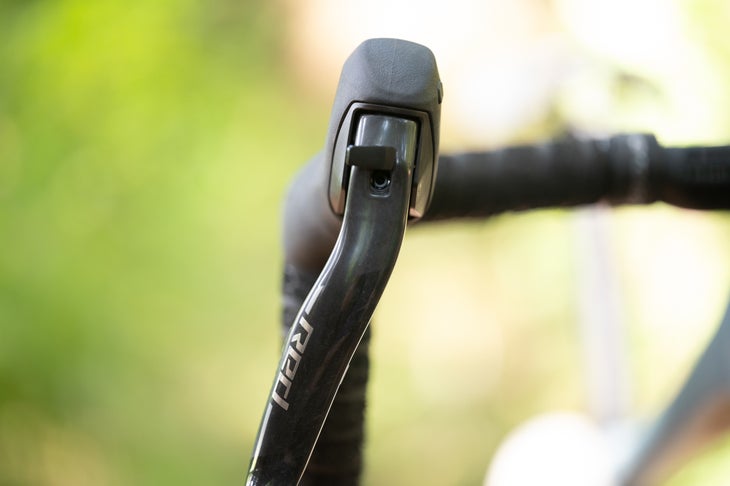
Conclusion
Let’s talk about complaints. For the people reading this, a big one is likely compatibility. You are invested in your bike and you care about cool new technology. You are thinking about upgrading and your bike might not be a UDH frame. You’ll need a new one.
The vast majority of the business SRAM does comes from OEM builds. This is also the top tier groupset. SRAM isn’t making apologies for that and not everyone will love that situation.
That leaves my only complaint as the hood shape. I don’t love it and I wish I did. I don’t actually care though. If I’m already here for 1×13 with fast electronic shifting and incredible braking then the hood shape is what it is. It’s not terrible anyway, it’s just not perfect for me.
That leaves philosophical considerations. If you prefer 2x on your gravel bike, turn your attention to Shimano. There are options for 2x SRAM on the gravel but that’s not where SRAM is focusing. If you like 1x but hate electronic shifting then again look at Shimano. I’ve not ridden GRX mechanical 1×12 but people I trust are very impressed. You could also look at SRAM for 1×12 mechanical but that’s a budget path vs a premium option. On the premium side of things another choice is Campagnolo for 1×13 mechanical with more frame compatibility. Campagnolo does not have the range of SRAM but it is 1×13, uses a standard hanger, and doesn’t have any batteries. Just keep in mind that Campagnolo parts are not easy to get if you are thinking of mechanical for reliability.
All that said, SRAM just set a new standard and, yes, you want this groupset. The 2024 SRAM Red XPLR AXS 1×13 gravel groupset absolutely owns high-end 1x gravel. It doesn’t matter if you are doing a short gravel race, a day on the bike with friends, or something truly epic. This groupset is nearly perfect.
Gallery
